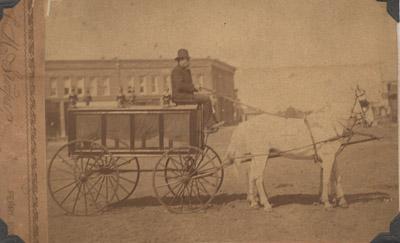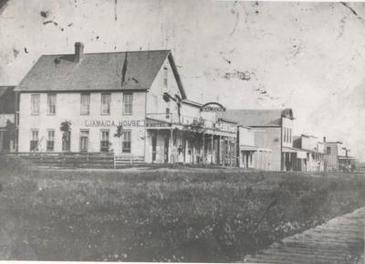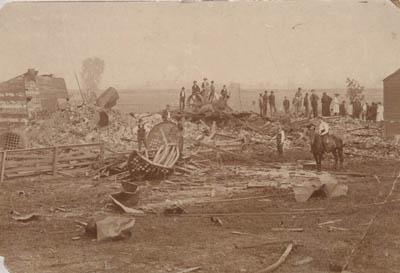|
Hello readers and welcome back to the Hometown Heritage blog! This morning I was watching the television while eating my breakfast, as I always do, and a segment came on about a new prototype car that was recently finished. This car, called the Hum-X for those interested, was special in that it could employ hydraulics to raise itself into the air and pass over other cars in traffic. This got me thinking about that today cars are everywhere and, aside from new ones like this, are no longer that amazing to us. However, this was not always the case. Look at the slide show below. As you can see, they are all pictures of people standing next to various cars. “What is so special about that” you might ask. That, my dear readers, is exactly my point. Today, we all take cars for granted and understand (generally) how they work. However, imagine just for a moment that you were living back in the late 1800s and early 1900s with these people. You are used to getting around via horseback or walking, and suddenly this metal mechanical marvel (or devil, depending on whom you ask) appears. It goes just as fast as any horse you have ever known and it never gets tired! Also buying one costs probably the same amount as a small house, yet somehow your father managed to bring one home. What else would you do but take a picture to mark this momentous occasion! Everyone will want to be able to remember the day your family first got its very own Model T. Yet, compared to today, no one seems to be as excited about his or her first car. Sure, teenagers get excited when their parents present them with the keys, but it is not the same kind of excitement as it was in the 1900s. Back then, it was something to parade about the whole town, showing all your friends and neighbors how lucky and wealthy your family is. Today it is something everyone simply expects to happen. Who knows, maybe in the future we will react to new invention as people in the 1900s did (fingers crossed for flying cars!). Do you remember your first car? Did you and your family all take pictures around it to mark the occasion? Let us know in the comments, and come back next week for another Hometown Heritage blog!
0 Comments
 Hello readers and welcome back to the Hometown Heritage Blog! Today I have another interesting photo from our collection for you all! Look at the picture that accompanies this post. What do you think it is? The picture itself is from 1885, and as you can see, it depicts a man on a cart drawn by a horse. The cart itself is rather fancy; it has what looks like curtains on the inside. Why does a cart need curtains? This, readers, is part of the answer! Curtains are usually meant to keep people on the outside from seeing the inside of a building or in this case, cart. Perhaps you are thinking that his wagon was used to transport money to and from banks? Unfortunately, if you are you will have to guess again! I imagine that someone transferring money would have a guard or two with him, and this man is clearly alone, so I doubt that he would be moving money. If you need another hint, I can tell you that the purpose of this cart was rather morbid. Let us put these two clues together: the cart wants to stop people from seeing inside it, and its purpose is rather morbid. Do you have another guess? If you guessed that this cart was a hearse, then you would be correct! This picture is of the first hearse in Perry in 1885, driven by Dave Willis. The hearse itself was by Carpenter and Son. The curtains on the inside are clearly used to hide the coffin from citizens the hearse might pass on the way to the cemetery. It makes me wonder if Dave Willis was also the undertaker or if he was simply the driver of the hearse. Unfortunately, our collection does not have any more information about this hearse or about how long it was in use. It is interesting, however, to see one of Perry’s firsts! Are you interested in seeing more of Perry’s firsts? Then swing by the Carnegie Library, the first library in Perry, and come back next week for another blog post!  Hello readers and welcome back to the Hometown Heritage Blog! I have a question for you to ponder, readers. Do you think that you could uproot yourself and your family, move to a new town, and open a new business to try to stay alive? Would you be able to leave your old life behind? I ask because this is exactly what Jacob Heater Jr. did in the year 1887. The year was 1887, and the country was in a serious depression after the high of the Civil War. Dubbed the “Gilded Age”, the time was characterized by a materialistic excess and extreme poverty. The term "gilded" referred to the idea that although on the surface everything seemed fine, like it was made of gold, this gold was just a thin coating that covered a life that was hard and unforgiving. Jacob and his wife Martha were trying to make a living on his farm, but were not succeeding. In an attempt to try to make enough money to survive, Jacob Heater Jr. uprooted his whole family and moved to Jamaica, Iowa. Many of you may be asking why, and the answer is that he attempted to start a Hotel. Named the Heater House Hotel, it was a building directly across from the Railroad Depot on the Southwest corner of Main Street in Jamaica. As you can see in the picture, it was a two-story building with a very big porch and balcony. The reason for this is that the Hotel shared its balcony with a saloon next door. In theory, this is a very promising partnership. The two buildings, located directly across from the Depot, would be able to draw in travelers for drinks at the saloon, then send them to the hotel when they needed a place to stay. Unfortunately, since times were so bad, the Heater House Hotel went broke after a few years. Jacob’s fate after his hotel is unknown, but hopefully he found another way to live! Readers, do you think you could do what Jacob did during a depression? Tell us in the comments! As a final note, we are drawing closer to the opening of the Gary Ernest Smith Exhibition! Remember to save August 23rd to your calendar as the opening reception here in Perry at the Hotel Pattee from 4:30 to 6:30 P.M. I hope to see you there!  Hello Readers, and welcome back to the blog! Perry has undergone many changes over the years, some quite a bit more drastic than others. For example, did you know that there used to be a different Light and Water plant in Perry? The old Light and Water Plant was a very interesting building. First, the building is not something that we see in America today, as we separate the water works and light works into separate buildings. However, what makes the old building so interesting is what happened to the building in July 1894 and to Henry Draper. Henry Draper was the Night Operator of the Light and Water Plant, and he was on his way to work on that fateful night in July. Little did he know, Henry was never going to do any work that night. As he was on his way to work, the Plant exploded. The cause of the explosion is unknown, but as you can see in the picture, the plant was flattened. Henry was unharmed, but unfortunately the Superintendent Henry Hock was killed in the explosion. It is a very curious case, and there is no information about the explosion in our collection other than the fact that it occurred. If you know anything else about the explosion, please share with us below in the comments! As a small side story, I will tell you what happened to Henry Draper after the explosion. He became a landscaper and sexton at the Violet Hill Cemetery. He did his job exceptionally well, to the point that when the plans for the cemetery were destroyed for a time, he was the only man to know where the more than 900 dead were buried! See you all next Wednesday! |
Archives
March 2020
Categories
All
|
All Rights Reserved, Fullhart Carnegie Charitable Trust, 2014-2023
This website is possible with the support of the
Dallas County Foundation
This website is possible with the support of the
Dallas County Foundation

 RSS Feed
RSS Feed